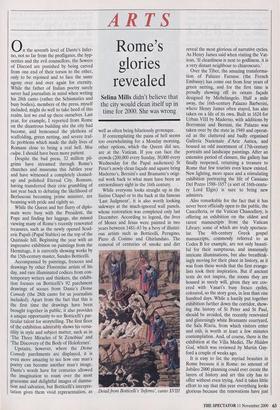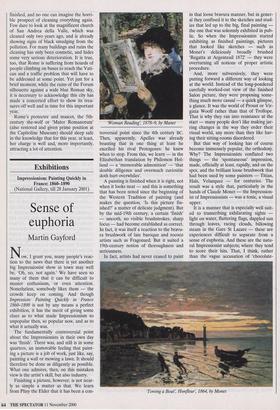ARTS
Rome's glories revealed
Selina Mills didn't believe that the city would clean itself up in time for 2000. She was wrong
On the seventh level of Dante's Infer- no, not so far from the profligates, the hyp- ocrites and the evil counsellors, the Sowers of Discord are punished by being carved from one end of their torsos to the other, only to be rejoined and to face the same agony over and over again for eternity. While the father of Italian poetry surely never had journalists in mind when writing his 28th canto (rather the Schismatics and busy bodies), members of the press, myself included, might do well to take heed of this realm, lest we end up there ourselves. Last year, for example, I reported from Rome on the disastrous building site the city had become, and bemoaned the plethora of scaffolding, green netting, and severe traf- fic problems which made the daily lives of Romans close to being a real hell. Mea culpa. I should have been more patient.
Despite the bad press, 32 million pil- grims have streamed through Rome's churches and museums this Jubilee year and have witnessed a completely cleaned- up and polished Eternal City. Romans, having transferred their civic grumbling of last year back to debating the likelihood of Berlusconi becoming prime minister, are beaming with pride and rightly so.
While the Queen and her flurry of diplo- mats were busy with the President, the Pope and finding her luggage, she missed viewing many of Rome's recently renovated treasures, such as the newly opened Scud- erie Papali (Papal Stables) on the top of the Quirinale hill. Beginning the year with an impressive exhibition on paintings from the Hermitage, it is currently showing works by the 15th-century master, Sandro Botticelli.
Accompanied by paintings, frescoes and drawings by other Florentine artists of his day, and rare illuminated codices from con- temporary writers and thinkers, the exhibi- tion focuses on Botticelli's 92 parchment drawings of scenes from Dante's Divine Comedy (the 28th canto for us journalists included). Apart from the fact that this is the first time the drawings have been brought together in public, it also provides a unique opportunity to see Botticelli's par- ticular talent for storytelling. The first floor of the exhibition admirably shows his versa- tility in style and subject matter, such as in `The Three Miracles of St Zenobius' and `The Discovery of the Body of Holofernes'.
Upstairs, however, where the Divine Comedy parchments are displayed, it is even more amazing to see how one man's poetry can become another man's image. Dante's words have for centuries allowed the imagination to roam over the most gruesome and delightful images of damna- tion and salvation, but Botticelli's interpre- tation gives them vivid representation, as well as often being hilariously grotesque.
If contemplating the pains of hell seems too overwhelming for a Monday morning, other options, which the Queen did see, are at the Vatican. If you can face the crowds (200,000 every Sunday, 30,000 every Wednesday for the Papal audiences) St Peter's newly clean façade and square bring Maderno's, Bernini's and Bramante's origi- nal work back to what must have been an extraordinary sight in the 16th century.
While everyone looks straight up in the Sistine Chapel or to the back at the famous `Last Judgment', it is also worth looking sideways at the much-ignored wall panels, whose restoration was completed only last December. According to legend, the lives of Moses and Jesus were painted in two years between 1481-83 by a bevy of illustri- ous artists such as Botticelli, Perugino, Piero di Cosimo and Ghirlandaio. The removal of centuries of smoke and dirt Detail from Botticelli's 'Inferno, canto XVIII reveal the most glorious of narrative cycles. As Henry James said when visiting the Vat- ican, 'If cleanliness is next to godliness, it is a very distant neighbour to chiaroscuro.'
Over the Tiber, the amazing transforma- tion of Palazzo Farnese (the French Embassy) has come out from four years of green netting, and for the first time is proudly showing off its ornate façade designed by Michelangelo. Half a mile away, the 16th-century Palazzo Barberini, where Henry James often stayed, has also taken on a life of its own. Built in 1624 for Urban VIII by Maderno, with additions by Borromini and Bernini, the Palazzo was taken over by the state in 1949 and operat- ed as the cluttered and badly organised Galleria Nazionale d'Arte Antica, and housed an odd assortment of 17th-century portraits and landscape paintings. After an extensive period of closure, the gallery has finally reopened, returning a treasure to Rome that few tourists even knew existed. New lighting, more space and a stimulating exhibition portraying the life of Cassiano Del Pozzo 1588-1657 (a sort of 16th-centu- ry Lord Elgin) is sure to bring new admirers.
Also remarkable for the fact that it has never been officially open to the public, the Cancelleria, or the Vatican Chancellery, is offering an exhibition on the oldest and rarest manuscripts from the Vatican Library; some of which are truly spectacu- lar. The 4th-century Greek gospel manuscripts, commonly referred to as Codex B for example, are not only beauti- ful for their sumptuous, and immensely intricate illuminations, but also breathtak- ingly moving for their place in history, as it was from these words that the first evange- lists took their inspiration. But if ancient texts do not inspire, the rooms they are housed in surely will, given they are cov- ered _with Vasari's busy fresco cycles, coloured, so the story goes, in less than one hundred days. While a hastily put together exhibition further down the corridor, show- ing the history of St Peter and St Paul, should be avoided, the recently renovated and glisteningly white Bramante courtyard, the Sala Riaria, from which visitors enter and exit, is worth at least a few minutes contemplation. And, of course, there is the exhibition at the Villa Medici, The Hidden God, which was reviewed by Martin Gay- ford a couple of weeks ago.
It is easy to list the myriad beauties in Rome because it is Rome: no amount of Jubileo 2000 planning could ever create the layers of history and art this city has to offer without even trying. And it takes little effort to say that this year everything looks glorious because the renovations have just finished, and no one can imagine the horri- ble prospect of cleaning everything again. Few dare to look at the magnificent church of San Andrea della Valle, which was cleaned only two years ago, and is already showing signs of black smudging from the pollution. For many buildings and ruins the cleaning has only been cosmetic, and hides some very serious deterioration. It is true, too, that Rome is suffering from hoards of people climbing on buses to reach the Vati- can and a traffic problem that will have to be addressed at some point. Yet just for a brief moment, while the ruins of the Forum silhouette against a wide blue Roman sky, it is necessary to acknowledge this city has made a concerted effort to show its trea- sures off well and in time for this important year.
Rome's protector and mascot, the 5th- century she-wolf or 'Mater Romanorum' (also restored and given prime position at the Capitoline Museum) should sleep safe in the knowledge that for this year, at least, her charge is well and, more importantly, attracting a lot of attention.



























































































 Previous page
Previous page